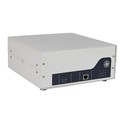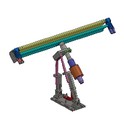Hey there! As a supplier of ultrasonic cleaning equipment, I've seen my fair share of issues that customers run into with their ultrasonic cleaners. In this blog post, I'm gonna walk you through some common problems you might encounter with your ultrasonic cleaner and how to troubleshoot them.
No Ultrasonic Activity
One of the most common problems is when your ultrasonic cleaner just doesn't seem to be working at all, like there's no ultrasonic activity. First things first, check if the cleaner is properly plugged into a working power outlet. Sounds simple, but you'd be surprised how often this is the culprit. Sometimes, the power cord might be loose or the outlet itself could be faulty. Try plugging in another device to the same outlet to see if it works.
If the power's all good, then take a look at the control panel. Make sure all the settings are correct. Some cleaners have a timer or an on/off switch that might have been accidentally turned off or set incorrectly. If you've double - checked these basic things and there's still no ultrasonic action, it could be an issue with the transducer.
Transducers are the parts of the ultrasonic cleaner that convert electrical energy into ultrasonic waves. If a transducer is damaged, it won't be able to generate those waves. Our ResoRod - 35 Ultrasonic Transducer for Cleaning is a great option if you need to replace a faulty transducer. You can also check for visible signs of damage on the transducer, like cracks or corrosion. If you spot any, it's probably time for a replacement.
Weak Ultrasonic Performance
Another problem you might face is weak ultrasonic performance. Your cleaner is working, but it doesn't seem to be cleaning as effectively as it used to. This could be due to a few reasons.
One possible cause is the cleaning solution. Over time, the cleaning solution can become dirty or depleted. Make sure you're using the right type of cleaning solution for your specific cleaning needs. Also, check the concentration of the solution. If it's too diluted, it won't be as effective. You might need to change the solution regularly, depending on how often you use the cleaner.
The temperature of the cleaning solution can also affect performance. Ultrasonic cleaners usually work best within a certain temperature range. If the solution is too cold, the ultrasonic waves might not be as effective. On the other hand, if it's too hot, it could damage the components of the cleaner. Check the user manual for the recommended temperature range and adjust accordingly.
The load in the cleaner can also play a role. If you're overloading the cleaner with too many items, the ultrasonic waves won't be able to reach all the surfaces properly. Try reducing the number of items you're cleaning at once to see if that improves the performance.
If none of these fixes work, it could be a problem with the transducer again. Maybe it's starting to wear out. We also offer the ResoRod - 30 Ultrasonic Transducer for Cleaning, which might be a good replacement option to boost the performance of your cleaner.
Excessive Noise
Is your ultrasonic cleaner making way too much noise? This can be really annoying, and it might also be a sign of a problem.
First, check if the cleaner is sitting on a stable surface. If it's vibrating against an uneven or unstable surface, it can create extra noise. Try moving the cleaner to a flat, sturdy table or countertop.


The level of the cleaning solution can also affect the noise level. If the solution is too low, the cleaner might make more noise. Make sure the solution level is within the recommended range in the user manual.
Sometimes, debris or foreign objects in the cleaner can cause noise. Check the bottom of the cleaner for any loose parts, dirt, or debris that might be rattling around. Clean out the cleaner thoroughly and see if the noise goes away.
If the noise persists, it could be a mechanical issue with the cleaner's components. In this case, it's best to get in touch with us for further troubleshooting or to discuss possible replacement parts. Our ResoRod - 40 Ultrasonic Transducer for Cleaning might be part of the solution if the noise is related to the transducer.
Leaking
A leaking ultrasonic cleaner is definitely a problem you don't want to deal with. First, check the seams and joints of the cleaner. Over time, the seals can wear out or become loose, causing leaks. If you find a leak at a seam, you might be able to use a suitable sealant to fix it. However, if the leak is coming from a more serious area, like a crack in the tank, it's probably time for a replacement.
Make sure the drain valve is properly closed. Sometimes, the valve can be accidentally left open or might not be sealing properly. Check for any signs of damage on the valve and replace it if necessary.
If you're still having trouble finding the source of the leak, it's a good idea to contact us. We can help you diagnose the problem and provide the right replacement parts or even a new cleaner if needed.
Overheating
If your ultrasonic cleaner is overheating, it's a serious issue that needs to be addressed right away. Overheating can damage the components of the cleaner and even pose a safety risk.
First, check the ventilation of the cleaner. Make sure there's enough space around the cleaner for air to circulate. If it's placed in a confined space, it won't be able to cool down properly.
The power settings could also be a factor. If you've been running the cleaner at a high power setting for a long time, it can cause overheating. Try reducing the power setting or taking breaks between cleaning cycles to let the cleaner cool down.
If the overheating continues, it could be a problem with the internal components, like the power supply or the transducer. In this case, it's best to stop using the cleaner immediately and contact us for assistance.
Conclusion
Troubleshooting problems with your ultrasonic cleaner can seem daunting, but by following these steps, you can often identify and fix the issues on your own. Remember, if you're ever in doubt or if the problem persists, don't hesitate to reach out to us.
As a leading supplier of ultrasonic cleaning equipment, we're here to help you keep your cleaners in top - notch condition. Whether you need replacement parts like our ResoRod - 35 Ultrasonic Transducer for Cleaning, ResoRod - 30 Ultrasonic Transducer for Cleaning, or ResoRod - 40 Ultrasonic Transducer for Cleaning, or if you're looking to purchase a new cleaner, we've got you covered.
If you're interested in learning more about our products or have any questions regarding troubleshooting your ultrasonic cleaner, feel free to contact us for a purchase consultation. We'll be more than happy to assist you in finding the best solutions for your ultrasonic cleaning needs.
References
- Manufacturer's user manuals for ultrasonic cleaning equipment
- Industry knowledge and experience in ultrasonic cleaning technology





